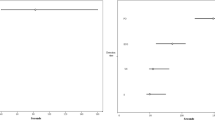Abstract
Purpose
To approach the clinical significance on detecting false non-reactive of non-stress test (NST) by improved acoustic stimulation.
Method
One-hundred and sixteen pregnant women who were at 34–41 weeks’ gestation were monitored for the fetal movement and the fetal heart rate. Then, the improved acoustic stimulation which was caused by clapping hands about 1 cm above maternal abdomen over the fetal vertex was given to the pregnant women whose NST were non-reactive.
Results
Among the 485 NST tests, 143 were non-reactive, accounting for 29.5%. With improved acoustic stimulation, 132 of them turned to be reactive, accounting for 92.3%. With oxygen therapy, 5 of the 11 changed to be reactive, but the other six pregnant women were given emergency caesarean section, and three of them were fetal distress. Among the 110 reactive pregnant women, only two were fetal distress. The sensitivity, specificity, positive, and negative predictive values for predicting fetal distress of NST with improved acoustic stimulation were 60.0, 97.3, 50.0, and 98.2%, respectively.
Conclusion
NST with improved acoustic stimulation is a convenient, fast, safe, and effective method on detecting false non-reactive NST and it can increase the specificity of NST.


Similar content being viewed by others
References
Suwanrath C, Suntharasaj T (2010) Sleep-wake cycles in normal fetuses. Arch Gynecol Obstet 281(3):449–454
Tan KH, Sabapathy A (2001) Fetal manipulation for facilitating tests of fetal wellbeing. Cochrane Database Syst Rev Issue 4. Art. No.: CD003396. doi:10.1002/14651858.CD003396
D’Elia A, Pighetti M, Vanacore F, Fabbrocini G, Arpaia L (2005) Vibroacoustic stimulation in normal term human pregnancy. Early Hum Dev 81(5):449–453
Khooshideh M, Izadi S, Shahriari A, Mirteymouri M (2009) The predictive value of ultrasound assessment of amniotic fluid index, biophysical profile score, nonstress test and foetal movement chart for meconium- stained amniotic fluid in prolonged pregnancies. J Pak Med Assoc 59(7):471–474
Ocak V, Demirkíran F, Sen C, Colgar U, Ocer F, Kilavuz O, Uras Y (1992) The predictive value of fetal heart rate monitoring: a retrospective analysis of 2165 high-risk pregnancies. Eur J Obstet Gynecol Reprod Biol 44(1):53–58
Batcha TM, Goonewardene IM (2005) The fetal acoustic stimulation test: a reliable and cost effective method of antepartum fetal monitoring. Ceylon Med J 50(4):156–159
Peleg D, Orvieto R, Sirota L, Ben-Rafael Z (1999) Neonatal atrial flutter following fetal exposure to vibroacoustic stimulation. Eur J Obstet Gynecol Reprod Biol 82(1):1–3
Müller H, Meinel K, Hampe K (1996) Methods, value and limits of prenatal hearing diagnosis. Zentralbl Gynakol 118(8):435–440
Kisilevsky BS, Muir DW, Low JA (1992) Maturation of human fetal responses to vibroacoustic stimulation. Child Dev 63(6):1497–1508
Nyman M, Arulkumaran S, Hsu TS, Ratnam SS, Till O, Westgren M (1991) Vibroacoustic stimulation and intrauterine sound pressure levels. Obstet Gynecol 78:803–806
Sohmer H, Perez R, Sichel JY, Priner R, Freeman S (2001) The pathway enabling external sounds to reach and excite the fetal inner ear. Audiol Neurootol 6(3):109–116
Conflict of interest
None.
Author information
Authors and Affiliations
Corresponding author
Rights and permissions
About this article
Cite this article
Xi, Q., Du, J., Liu, X. et al. Clinical study on detecting false non-reactive of non-stress test by improved acoustic stimulation. Arch Gynecol Obstet 284, 271–274 (2011). https://doi.org/10.1007/s00404-010-1621-z
Received:
Accepted:
Published:
Issue Date:
DOI: https://doi.org/10.1007/s00404-010-1621-z




